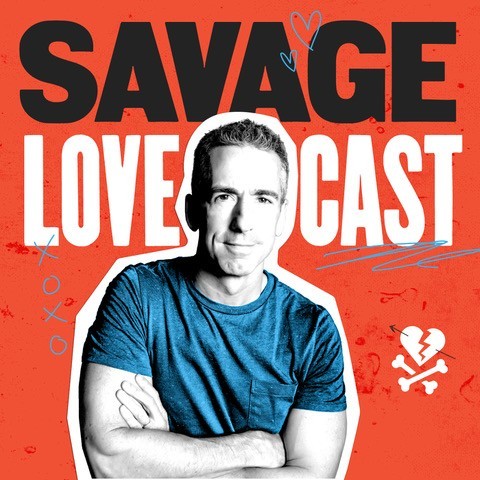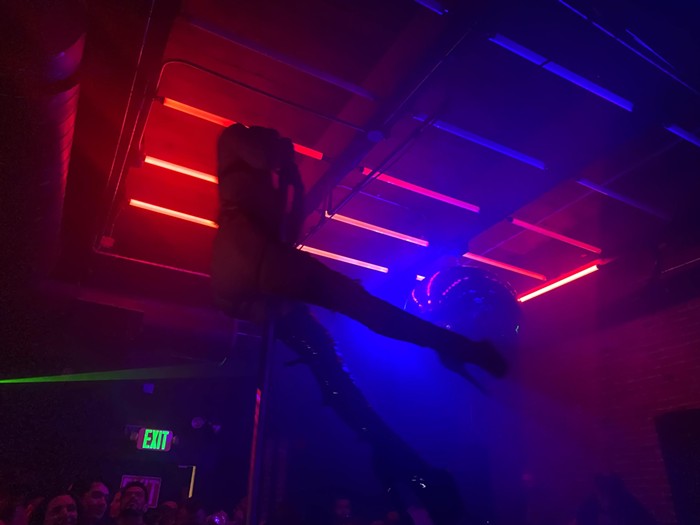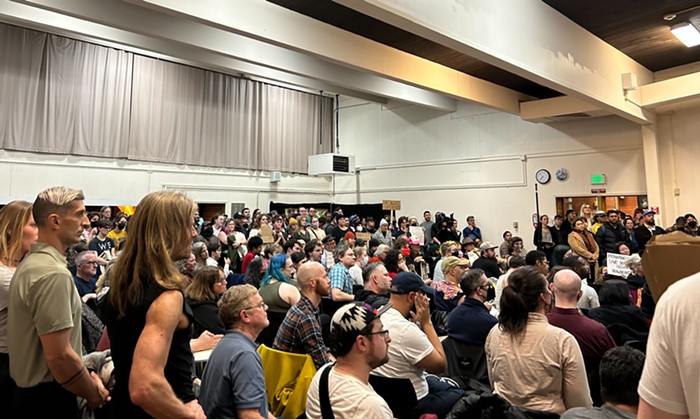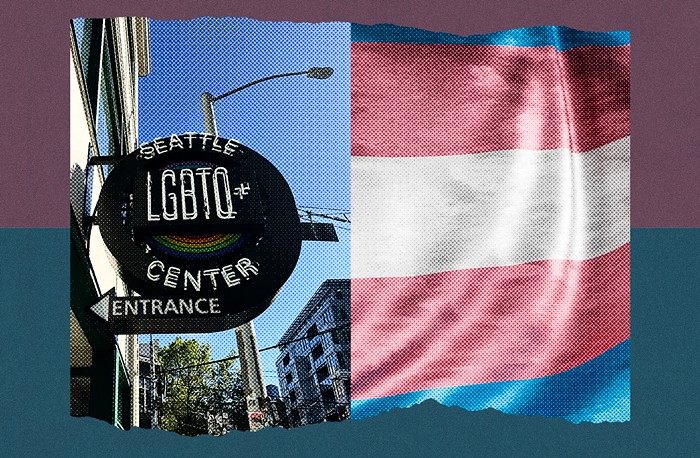Walking down Supernova’s hall of mirrors entrance earlier this month, I could feel the heat of the party before I entered the room.
Despite the Thursday night’s chill, local party startup Sapphic Seattle had packed the SoDo nightclub with hundreds of queer women and non-binary people in search of hotties and a good time. The night’s Sapphic Prom theme meant that many party attendees were wearing the formal attire of their gay dreams—mascs in sharp suits, femmes in skimpy dresses, some hero in intricate Victorian garb. The wristbands given to patrons at the beginning of the night—yellow for “friendly,” pink for “flirty and friendly”—glowed under the UV lights, making it easy to tell who was down for what.
On the club’s upper floor, a photographer operated a glittery photobooth for queer friends and lovers to have a second, queerer chance at a prom photo—one they could feel proud of. And on Supernova’s lower floor, things got sweaty. When I arrived, party attendees were stuffed cheek-by-jowl on the dance floor, bumping and grinding to female pop diva power anthems by the likes of Doja Cat and Megan Thee Stallion selected by DJ SummerSoft. Onstage, dancers Lavender, Onyx Wolf, and Harley B twerked and took tips. And on the dance floor, off the dance floor, in line for the bathroom, pushed up against the arcade games, people were hardcore snogging without a care in the world. Others stood alone gleefully taking in the women- and enby-centric party’s raucousness.
“I never realized clubbing could be so fun,” said 29-year-old Kate, a gay-leaning bisexual who led worship at church before recently coming out. While waiting in the interminable bathroom line, she told me she drove by herself all the way from North Everett just to have her first Sapphic-partying experience. “I work in the morning, but I think it’s worth it to stay!”
At just over a year old, Sapphic Seattle has already had an outsized impact on the queer nightlife scene in the city. Boasting over 18,000 followers on Instagram and racking up millions of likes and views on TikTok, what started as a DIY house party has grown into sold-out themed club nights drawing in thousands of Sapphics—a term used to describe women and non-binary people attracted to women and non-binary people; more on that later—from across the region every month. And as Sapphic Seattle prepares for its first official Pride, it’s clear that this is just the beginning.
Sapphic Seattle founder Hannah Balducci started the party out of frustration. Seattle may be one of the gayest cities in the country, but there weren’t many consistent (and appealing) options for queer women to meet and get freaky with other queer women. Especially in the age of COVID, dating apps reign as the primary way for queer women and non-binary people to connect. And, speaking from my experience, it really blows.
“I was seeing parties in New York and LA and I thought, why do these big cities get massive blowout parties where you see women and Sapphics having these incredible nights, whereas in Seattle there’s a million general nights that are very male-dominated,” Balducci told me in an interview. “There’s nothing femme-centric whatsoever.”
So Balducci got to work on Tinder, Hinge, Bumble, TikTok, Lex, and Facebook to drum up interest in IRL gatherings with other Sapphic-identifying people. She swiped right on every profile on every dating app and told her matches about whatever party the group was planning next. She posted in Facebook groups and made several TikToks a day, gaming the algorithm into making her posts go viral (they did). Soon, Sapphic Seattle saw its follower and attendee counts grow nearly vertically as social media interest in the group piqued.
“It definitely wasn’t accidental,” said Balducci. “It was a lot of very meticulous swiping and posting TikToks.”
View this post on Instagram
The group’s early gatherings in 2021 were mostly limited to beach hangs or house parties. It was after a huge December event at the woman-owned Moses Auto in South Seattle that it became clear future events would have to be much bigger. Unfortunately, that realization came just as the Omicron variant rocked the nightlife scene, forcing nightclubs to back off big events for a while. After a brief switch to virtual events, including a Minecraft server for queers to hang out on, Sapphic Seattle made their big sold-out nightclub debut at Supernova in March and never looked back. In 2022, Siobhan Fox, Varsha Nandula, and Eve Matson were brought onto the leadership team to help guide the group. “The jump from a medium-sized venue like Moses Auto—which was just a DIY party—to Supernova was massive,” said Balducci. “That’s skipping 50 to 100 steps for sure.”
But what does Sapphic actually mean? The word has caused a lot of confusion amongst me and my queer friends. Who does it include? Who doesn’t it include? Was it chosen for this party for its alliterative appeal or do people really identify this way? Do I have to identify that way to have fun at this party?
The word “sapphic” is derived from Sappho of Lesbos, an ancient Greek poet who, at least in popular imagination, is most famous for her epic lyrical and erotic poems yearning for women. After a few of Sappho’s scrolls were discovered in the late 19th century, “sapphic” became a term used to describe women who love women, its popular meaning, synonymous with “lesbian,” spiking in the 1950s. As lesbian website Autostraddle discovered, there has been an uptick in its usage in the past few years as an umbrella term to include lesbian, bisexual, and non-binary identities. This is the usage Sapphic Seattle prefers.
“We use it as a term that people self-identify with. It’s less strict about who can apply that label to themselves,” said Eve Matson, Sapphic Seattle’s logistics and supply coordinator. “We want to be very clear what we include trans people and non-binary people who feel like this community is theirs. This isn’t a community that we want to gatekeep.”
While waiting in line to get into the venue, I chatted up a trans masc non-binary lesbian in front of me who had been to Sapphic Seattle before. They told me they liked the term “Sapphic” and didn’t feel excluded by it. “I just like that I can go somewhere that’s queer and not jus cis gay men,” they said, laughing.
View this post on Instagram
Before walking through the party, I felt a little apprehensive about the demographics of the crowd. From some of Sapphic Seattle’s Instagram and TikTok videos, I surmised that a lot of attendees would be young, mostly white, and femme. I worried about being the slightly older, cranky, Black they/them in a sea of just-discovering-bars-after-turning-21-during-COVID gays. Spending time swirling through the party’s two floors, that assumption was largely true; however, there was certainly a wider variety of people than I expected. A group of studs here, one or two dozen Black and brown femmes there, a healthy mix of mascs throughout. Young queers dominated, but many of the women I spoke to were around my age and going to a Sapphic-centric club night for the first time.
“I love Neighbours,” said Samantha, a 28-year-old lesbian who found out about the party on Instagram. “But sometimes I wanna go hard with the women.”
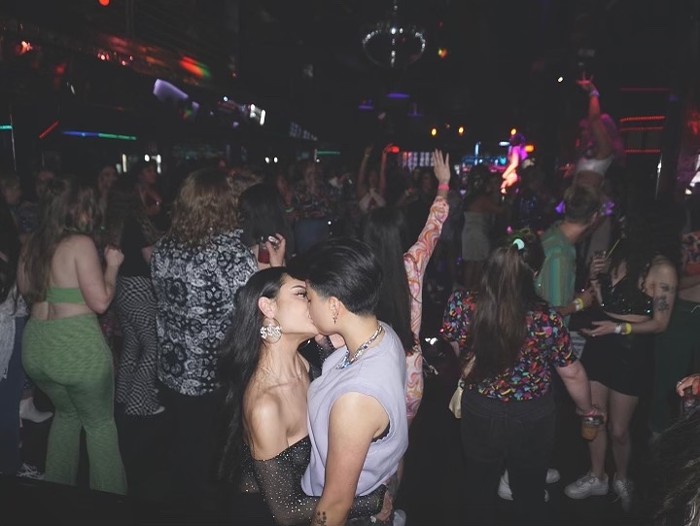
With lesbian bars and clubs in serious decline across the country, this can be easier said than done. According to the Lesbian Bar Project (LBP), there were an estimated 200 lesbian bars across the United States in the late 1980s. Now, there are only 21. “Without space, we lose power, validity, communal safety, and intergenerational dialogue,” writes LBP on their website. Luckily for us Seattelites, Wildrose has held down the lesbian and lesbian-allied community for 37 years (and their Pride looks like fun). But there’s still a huge gap in the market for inclusive, queer-centric club nights in bigger spaces.
In recent years, there have been popular dance nights like Night Crush, which specifically centered queer and trans people of color, at Rebar (R.I.P.), but in the post-COVID era, Sapphic Seattle has been one of the most prominent organizers in this space. Of course, Sapphic Seattle certainly isn’t the first group to fill the gap.
In the early 2000s in Seattle, Lisa Orth, former lesbian club night promoter, saw a similar void in the market for lesbian club nights and organized no fewer than four: Make Out at Baltic Room, Vibrator at The Eagle, Le Freak at Wildrose, Cherry (yes, the inspiration for that new nightclub) at the War Room and Rebar, and Hot Box at ARO.space. All nights were “well supported by the community and well attended,” she said in an email.
There were certainly more gay venues in the late ’90s, like Eastlake East and The Easy, but that didn’t temper the need or enthusiasm from the lesbian community for new nights. “I just remember the whole scene was always so excited to go out and everyone did whenever there was a new night,” wrote Orth. “From what I can tell, it seems similar to the excitement happening now surrounding the Sapphic Seattle events.”
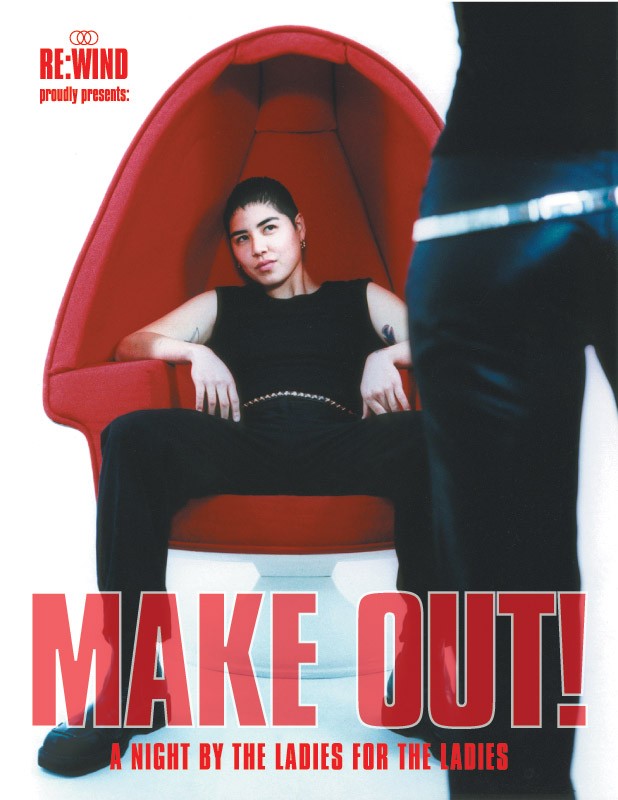
Back at Sapphic Prom, I stood on the balcony watching queers do math onstage. The night’s host, Shadae Simone, teetered on the edge of Supernova’s giant disco ball DJ booth cheering on two attendees to solve math equations on a whiteboard. The answers were both horny (“69”) or gay (“The limit does not exist”). Earlier in the evening, Simone had ordained certain crowd members as “prom royalty,” bequeathing them with raffle tickets, sashes, and boutonnières. “Also called ‘bottom-nières,’” Simone joked. Sapphic Seattle employs more interactive elements than a typical club night, the group’s leadership told me, to facilitate more interaction amongst the crowd. And the color-coded wristband system “establishes a general culture of consent in the space,” said Balducci.
As for Sapphic Seattle’s first Pride next week, the group has big plans. They’re hosting two giant events that weekend: Isle of Sappho, a sold-out “ancient island party” in honor of their namesake on June 23 at Supernova, and Sapphic Pride: Y2K Edition, a post-Pride Parade sapphic gathering at Neighbours on June 26.
View this post on Instagram
And for the first time, they will be walking in the Seattle Pride Parade downtown with Supernova and the Beauty Boiz. Varsha Nandula, the group’s volunteer manager and photographer, said she “could not be more excited” to be part of the parade proceedings as this is her first in-person Pride as well. “Every time we’re shocked at the recognition we’re getting from the Seattle community,” she said. “It means a lot to us.”
Now, with nearly a year of experience and several months of in-person club night events, Sapphic Seattle is looking to expand to other cities. Its popularity on TikTok and other social media platforms is indicative of that so-called “gap in the market” for Sapphic parties, not only in Seattle, but in other regions. But Sapphic Seattle’s social media and business manager Siobhan Fox wants to make sure those platforms aren’t just inflating their egos.
“We’re listening to feedback, making sure that we’re still evolving and not just riding the high of the very explosive social media growth,” said Fox. “[We want] it as high-caliber as it can be in Seattle and then ultimately other cities, if there is a community there for us.”
Sapphic Seattle is hosting Isle of Sappho on June 23 at Supernova and Sapphic Pride: Y2K Edition at Neighbours on June 26. Text 1-844-SAPPHIC for presales and other surprises. And if you are going, there are a few rules: One, be vaccinated. Two, don’t hunt for unicorns. (We can joke about “We saw you from across the bar” couples, but these parties are not the venue for doing that.)




